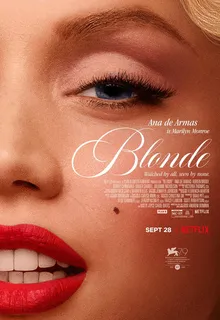Historical accuracy of Blonde

Historical accuracy of Blonde

Characters
Norma Jeane Mortenson / Marilyn Monroe (Ana de Armas)
Based on the real person, but the portrayal heavily emphasizes trauma, victimhood, and invented/speculative events from Oates's novel, rather than a balanced biographical depiction of her intelligence, career agency, or complexities.
Gladys Pearl Baker (Julianne Nicholson)
Based on Monroe's real mother who suffered from severe mental illness (paranoid schizophrenia) and was institutionalized. The film depicts specific abusive incidents (like the attempted drowning) that are fictional inventions from the novel, not documented facts.
Cass Chaplin (Xavier Samuel)
Based on Charles Chaplin Jr., who did have a brief affair with Monroe and wrote about it. The film's depiction of a polyamorous relationship ("throuple") involving him, Monroe, and Eddy Robinson Jr. is a fictional element from the novel with no basis in fact.
Eddy G. Robinson Jr. (Evan Williams)
Based on Edward G. Robinson Jr. Monroe was acquainted with him, but the polyamorous relationship depicted in the film alongside Cass Chaplin Jr. is fictional, originating from the novel.
The Ex-Athlete (Bobby Cannavale)
Based on Joe DiMaggio. Their marriage was indeed short and tumultuous, and reports suggest he was possessive and potentially abusive, particularly regarding her public image (like the Seven Year Itch scene). The film depicts this known volatility.
The Playwright (Adrien Brody)
Based on Arthur Miller. Their marriage and intellectual connection are historical fact. The film accurately includes Miller using aspects of Monroe in his writing, which caused friction.
More characters
The President (Caspar Phillipson)
Clearly represents John F. Kennedy. While rumors of an affair existed, the film depicts a graphic, non-consensual sexual encounter based on fictional speculation from the novel. There is no historical evidence for this specific event or relationship dynamic.
Allan "Whitey" Snyder (Toby Huss)
Based on Monroe's real-life longtime makeup artist and friend. The depiction of him as a consistent, supportive presence seems generally accurate to their known relationship.
Mr. Shinn (Dan Butler)
Likely a composite or fictional character representing the agents and handlers Monroe dealt with throughout her career.
Mr. Z (David Warshofsky)
Likely based on Darryl F. Zanuck, head of 20th Century Fox. The depiction of a powerful executive exploiting Monroe (casting couch scene) reflects rumored industry practices but is a fictionalized specific event.
Story
Childhood trauma with mentally ill mother
Monroe's mother did suffer from severe mental illness, leading to Monroe's unstable childhood in foster care. Specific events like the attempted drowning are fictionalized elements from the novel.
Belief Clark Gable was her father
Monroe did entertain the idea Gable might be her father (based on a photo her mother showed her), though she didn't pursue it as obsessively as depicted. Her biological father was later identified via DNA as Charles Stanley Gifford.
Polyamorous relationship with Chaplin Jr. & Robinson Jr.
This "throuple" is a significant fictional invention from Oates's novel. While Monroe knew both men (and briefly dated Chaplin Jr.), there's no evidence of this relationship.
Forced abortion early in career
The film depicts a forced abortion. There is no concrete historical evidence Monroe ever had an abortion, forced or otherwise. This is a speculative element from the novel reflecting rumors and industry pressures of the time.
Second depicted abortion (talking fetus)
This depicts another abortion, including surreal elements like a talking fetus expressing regret. This is entirely fictional, lacks historical basis, and drew criticism for its portrayal.
Miscarriage during marriage to Arthur Miller
Monroe did suffer multiple miscarriages during her marriage to Miller, which caused her great distress. The specific cause shown in the film (tripping on a beach) appears fictionalized.
Abusive marriage to Joe DiMaggio
Historical accounts confirm the marriage was volatile and short-lived, with DiMaggio being possessive and likely physically abusive, especially after the Seven Year Itch skirt scene.
Arthur Miller using Monroe's life/words in his writing
Miller did incorporate aspects of Monroe and their relationship into his work (e.g., The Misfits, After the Fall), which caused tension between them.
Sexual assault by "Mr. Z" (studio head)
Depicts a "casting couch" scenario. While such exploitation occurred in Hollywood, this specific incident is fictionalized. Monroe spoke of difficult encounters but not this specific alleged assault.
Sexual assault by "The President" (JFK)
Depicts a graphic, non-consensual sexual encounter. While an affair was rumored, there is no historical evidence supporting this assault narrative, which originates from the novel's speculation and caused significant controversy.
Substance abuse contributing to decline
Monroe's struggles with addiction, particularly to barbiturates, are well-documented and contributed to her professional difficulties and premature death.
Death by overdose (portrayed as potentially non-accidental)
Monroe died from a barbiturate overdose, officially ruled a "probable suicide." The film depicts her death with surreal imagery and implies potential external involvement based on novelistic speculation/conspiracy theories.
Setting
Hollywood Studio System (1940s-1960s)
Captures the visual aesthetic and atmosphere of the era, including studio sets, premieres, and the powerful role of studios in shaping stars' images and lives.
Mid-Century Fashion and Styling
Costumes and makeup meticulously recreate many of Monroe's iconic looks and the general fashion trends of the 1940s, 50s, and early 60s.
Film Set Recreations
Visually recreates famous scenes and photo shoots from Monroe's career (e.g., Gentlemen Prefer Blondes, The Seven Year Itch skirt scene) with notable attention to detail.
Celebrity Culture and Paparazzi
Portrays the intense media scrutiny and public obsession that surrounded Monroe, contributing to the pressure she experienced.
Architecture and Interiors
Sets representing homes, apartments, hotel rooms, and studios effectively evoke the design styles of the mid-20th century.
Atmosphere of Exploitation and Misogyny
While specific events are fictionalized, the film effectively portrays the documented sexism and exploitation prevalent in the Hollywood system during that era.
